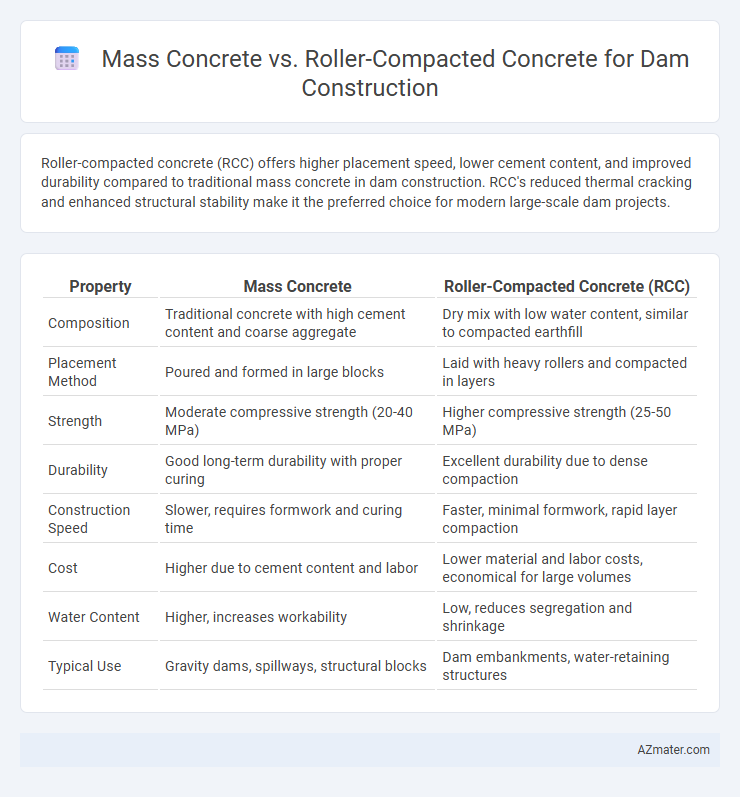Roller-compacted concrete (RCC) offers higher placement speed, lower cement content, and improved durability compared to traditional mass concrete in dam construction. RCC's reduced thermal cracking and enhanced structural stability make it the preferred choice for modern large-scale dam projects.
Table of Comparison
| Property | Mass Concrete | Roller-Compacted Concrete (RCC) |
|---|---|---|
| Composition | Traditional concrete with high cement content and coarse aggregate | Dry mix with low water content, similar to compacted earthfill |
| Placement Method | Poured and formed in large blocks | Laid with heavy rollers and compacted in layers |
| Strength | Moderate compressive strength (20-40 MPa) | Higher compressive strength (25-50 MPa) |
| Durability | Good long-term durability with proper curing | Excellent durability due to dense compaction |
| Construction Speed | Slower, requires formwork and curing time | Faster, minimal formwork, rapid layer compaction |
| Cost | Higher due to cement content and labor | Lower material and labor costs, economical for large volumes |
| Water Content | Higher, increases workability | Low, reduces segregation and shrinkage |
| Typical Use | Gravity dams, spillways, structural blocks | Dam embankments, water-retaining structures |
Introduction to Dam Construction Methods
Mass concrete and roller-compacted concrete (RCC) are two primary materials used in dam construction, differing significantly in placement and composition. Mass concrete is a traditional, low-slump mixture poured in large volumes, requiring extensive curing to manage heat of hydration and prevent cracking. Roller-compacted concrete incorporates a drier mix that can be compacted with rollers, enabling faster construction and improved cost efficiency while maintaining structural integrity for gravity dam applications.
Overview of Mass Concrete
Mass concrete is characterized by its large volume and low heat of hydration, crucial for minimizing thermal cracking in dam construction. It relies on slow strength gain and careful temperature control to maintain structural integrity during curing. This type of concrete uses conventional placing methods and extensive formwork, contrasting with roller-compacted concrete's rapid placement and compaction techniques.
Understanding Roller-Compacted Concrete (RCC)
Roller-Compacted Concrete (RCC) for dam construction offers a rapid placement method using a dry concrete mix with minimal water, enhancing compaction through heavy rollers similar to asphalt paving. Compared to traditional mass concrete, RCC provides improved durability, reduced construction time, and cost-efficiency due to its layered placement and high-density structure. RCC's lower cement content and optimized aggregate gradation contribute to reduced thermal cracking risks, making it a preferred method in modern dam engineering projects.
Key Material Properties Comparison
Mass concrete used in dam construction typically features a lower cement content with higher aggregate volume, resulting in reduced heat generation and enhanced thermal control compared to roller-compacted concrete (RCC). Roller-compacted concrete incorporates a drier mix with less slump, allowing for faster placement and compaction but demands precise moisture control and aggregate gradation to achieve adequate density and strength. Both materials require careful attention to thermal properties, permeability, and compressive strength to ensure structural integrity and long-term durability in dam applications.
Construction Techniques: Mass Concrete vs RCC
Mass concrete construction involves placing large volumes of concrete in a formwork, allowing gradual curing to control heat generation and avoid thermal cracking, which requires substantial formwork and extended curing times. Roller-compacted concrete (RCC) utilizes a dry mix compacted with rollers similar to asphalt paving, enabling faster placement, reduced formwork, and accelerated construction schedules while maintaining structural integrity. RCC is favored for dam construction due to its cost-effectiveness, speed, and reduced thermal strain compared to traditional mass concrete techniques.
Advantages of Mass Concrete in Dams
Mass concrete offers superior durability and strength, making it ideal for dam construction where long-term stability is critical. Its ability to absorb and distribute vast loads reduces the risk of structural failure under high hydrostatic pressure. Additionally, mass concrete's lower permeability enhances resistance to water seepage, ensuring the integrity and safety of the dam over time.
Benefits of Roller-Compacted Concrete for Dams
Roller-compacted concrete (RCC) offers significant benefits for dam construction, including faster placement rates and reduced construction time compared to conventional mass concrete. RCC's lower water content improves durability and reduces the risk of thermal cracking, enhancing structural integrity. The compaction process results in a dense, strong material that minimizes permeability, thereby increasing the dam's long-term stability and performance.
Cost and Time Efficiency Analysis
Mass concrete offers lower initial material costs but requires longer curing times, increasing overall project duration and labor expenses in dam construction. Roller-compacted concrete (RCC) significantly reduces construction time through rapid placement and compaction, leading to lower labor and equipment costs despite slightly higher material expenses. Cost and time efficiency analysis indicates RCC is preferable for large-scale dams due to faster project completion and optimized resource allocation.
Performance and Durability in Dam Structures
Mass concrete exhibits excellent durability in dam structures due to its low permeability and high thermal capacity, which reduce the risks of cracking from thermal stresses. Roller-compacted concrete (RCC) offers superior performance by enabling faster construction with consistent density and strength through compaction, while maintaining durability comparable to conventional mass concrete. Both materials provide robust resistance to weathering, chemical attack, and mechanical stress, making them suitable for the long-term stability of large dam projects.
Selecting the Optimal Method for Dam Projects
Mass concrete offers high compressive strength and excellent durability, making it ideal for gravity dams requiring significant structural integrity. Roller-compacted concrete (RCC) allows faster placement with lower costs and reduced construction time, suitable for large-scale dam projects like embankment dams. Selecting the optimal method depends on project-specific factors such as load requirements, site conditions, cost constraints, and environmental impact assessments.

Infographic: Mass concrete vs Roller-compacted concrete for Dam construction
 azmater.com
azmater.com